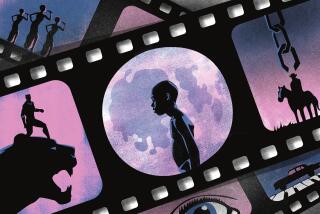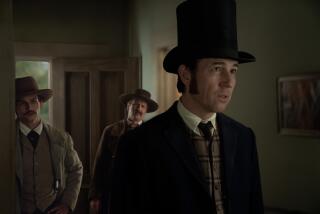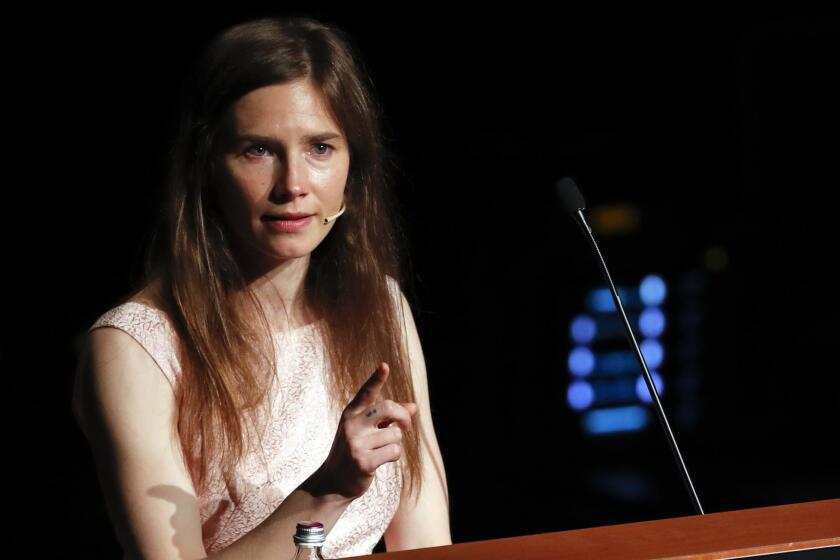‘UNCLE TOM’S CABIN’ MINUS STEREOTYPES
- Share via
For a whole generation of black Americans, especially those reared on the black pride movement of the 1960s, the term Uncle Tom is the ultimate put-down--synonymous with a no-esteem, sellout black.
Director Stan Lathan, however, has a different view. He says the original Uncle Tom “was a gentleman . . . a man of God who stood up for what he believed in . . . a man of principle and commitment . . . a leader.”
It’s this view that Lathan brings to cable television Sunday with the premiere of a new dramatization of Harriet Beecher Stowe’s classic “Uncle Tom’s Cabin.” The two-hour film, starring Avery Brooks as Tom and featuring Phylicia Rashad of “The Cosby Show,” Bruce Dern and “The Equalizer’s” Edward Woodward as the sadistic plantation owner Simon Legree, debuts on Showtime at 8 p.m., with additional airings June 20, 24 and 29.
From the first shots of Brooks, virile and fatherly with a voice that fills the cabin, it’s clear that this Tom is different from the one that shuffles in the back of America’s mind.
Yet when the pay channel approached Lathan--whose credits range from “Hill Street Blues” to an adaptation of James Baldwin’s “Go Tell It on the Mountain” for PBS--he reacted with “an unequivocal ‘No, I’m not interested.”
“I’ve done several films that were about slavery or set in the South and I felt that I had done (enough). I had my fill of it. And the thought of doing ‘Uncle Tom’s Cabin’--I couldn’t get excited about it,” the 36-year-old director said with a chuckle.
His attitude changed when Edgar Scherick, “Tom’s” executive producer, called him.
“He and Showtime were very serious. So I read the script by John Gay, who is a very good writer,” said Lathan. Because of the script, “I re-read the book and was surprised about the sensitivity that Harriet Beecher Stowe, a white woman, showed for a black man 150 years ago.
“Here was the book that sparked the abolitionist movement and I’m sure it had a role in starting the Civil War--which brought about the end of slavery. Yet we still have a stigma attached to ‘Uncle Tom’ today,” he said. “The challenge started to fascinate me.”
It wasn’t the challenge that attracted Scherick, the producer who first tried to sell the project to NBC six years ago. It was the “historical significance and the fact that it’s a good yarn,” he said.
Set in 1852 in Mississippi, Stowe’s novel is the odyssey of a pious slave whose attempts to protect his family and other slaves exposes him to a string of brutalities and finally leads to his death.
NBC commissioned Gay’s script but ultimately decided not to make it. However, one of the network’s programmers, Allen Sabinson, remembered it when he moved to Showtime as vice president of original programming. When Scherick suggested resurrecting the project, Sabinson agreed.
The actor Lathan suggested for Uncle Tom thought the notion was absurd.
“I actually laughed when first contacted about filming ‘Uncle Tom’s Cabin,’ ” said Brooks, who plays the character Hawk on ABC’s “Spenser: For Hire.” “But then I read the script and it was straightforward and honest.”
Stowe’s Tom “was the antithesis of what we call an ‘Uncle Tom’ today,” Lathan said.
“He worked for three masters, managed the business affairs of each of them and refused to escape one plantation because the master would have to sell 10 other slaves to replace him. Tom was a heroic martyr. Other slaves wanted to be like him.”
Because of his unwavering commitment to nonviolence, Tom could even be likened to Martin Luther King Jr., Lathan said, and in that respect could even be inspirational.
“I have teen-agers who watch a lot of television. I direct a lot of television. I’d much rather they look at Tom as a role model as portrayed by Avery Brooks as opposed to Tubbs on ‘Miami Vice’ or ‘Remington Steele,’ ” Lathan said.
Brooks said that he based his performance on the life of Josiah Henson, reputedly Stowe’s inspiration for her novel. “He was a slave who escaped from the South to freedom in Canada, carrying his children all the way,” the actor said. “My research and reading years ago of Henson’s autobiography, first published in 1848, provided a solid foundation for my approach.”
Errol Hill, a professor of drama and oratory at Dartmouth College who wrote a paper entitled “The Case Against Uncle Tom’s Cabin,” said “that while in some ways (Henson’s) life paralleled Uncle Tom’s, whether in fact (Stowe) based (Uncle Tom’s Cabin) on his life . . . has never been established.”
Hill does agree with Brooks, though, about how the image of this seemingly heroic character of Uncle Tom deteriorated to the point of being regarded as a pathetic weakling. They say that Uncle Tom was misinterpreted in melodramatic stage productions of “Uncle Tom’s Cabin” that took place from the time of the novel’s publication in 1852 through the 1920s.
“The figures of the blacks, in particular Uncle Tom, became stereotyped, and quite undermined the original intentions of (Stowe),” Hill said. These productions were “in the main done by whites in blackface.”
“So whereas the initial response to the novel by important black people was very positive, after Reconstruction, blacks began to feel that the Uncle Tom figure was much too compliant, much too forgiving, much too lacking in militancy . . .
“So you get this buildup of resentment against Uncle Tom . . . to the point that in 1945, a musical version was banned in New Haven and Bridgeport, Conn., and Springfield, Ill.,” he said. “People just didn’t want to have it anymore.”
The problem became more acute as the years passed because fewer people read the original novel, added Jeanne-Marie Miller, vice president of academic affairs at Howard University.
Marie, a lecturer on pre-20th century black drama, said that she doesn’t think most college students have ever read “Uncle Tom’s Cabin.” “So they hear the term Uncle Tom and it’s a very derisive term and they use it not really knowing what the real character Uncle Tom was in the book,” she said.
“Although he was passive, there are a few lines that Stowe gave him . . . that remove him from being the very, very contented slave that didn’t want freedom,” she said.
Brooks said that three Hollywood versions of the story during the 1920s didn’t improve the situation.
“The large-scale 1927 Universal Studios production featured only one black actor--James B. Lowe as Uncle Tom. Ironically, the other black roles featured whites in blackface,” Brooks said.
The Showtime production is “substantially different,” he said.
Lathan agrees. Showtime subscribers put off simply by the title’s contemporary meaning will miss “a good movie . . . with strong acting on the part of all the characters, a good yarn and probably a more realistic adaptation than Harriet Beecher Stowe (envisioned),” he said. “It’s a conscientious black man’s perception of that genre.”
More to Read
The complete guide to home viewing
Get Screen Gab for everything about the TV shows and streaming movies everyone’s talking about.
You may occasionally receive promotional content from the Los Angeles Times.






